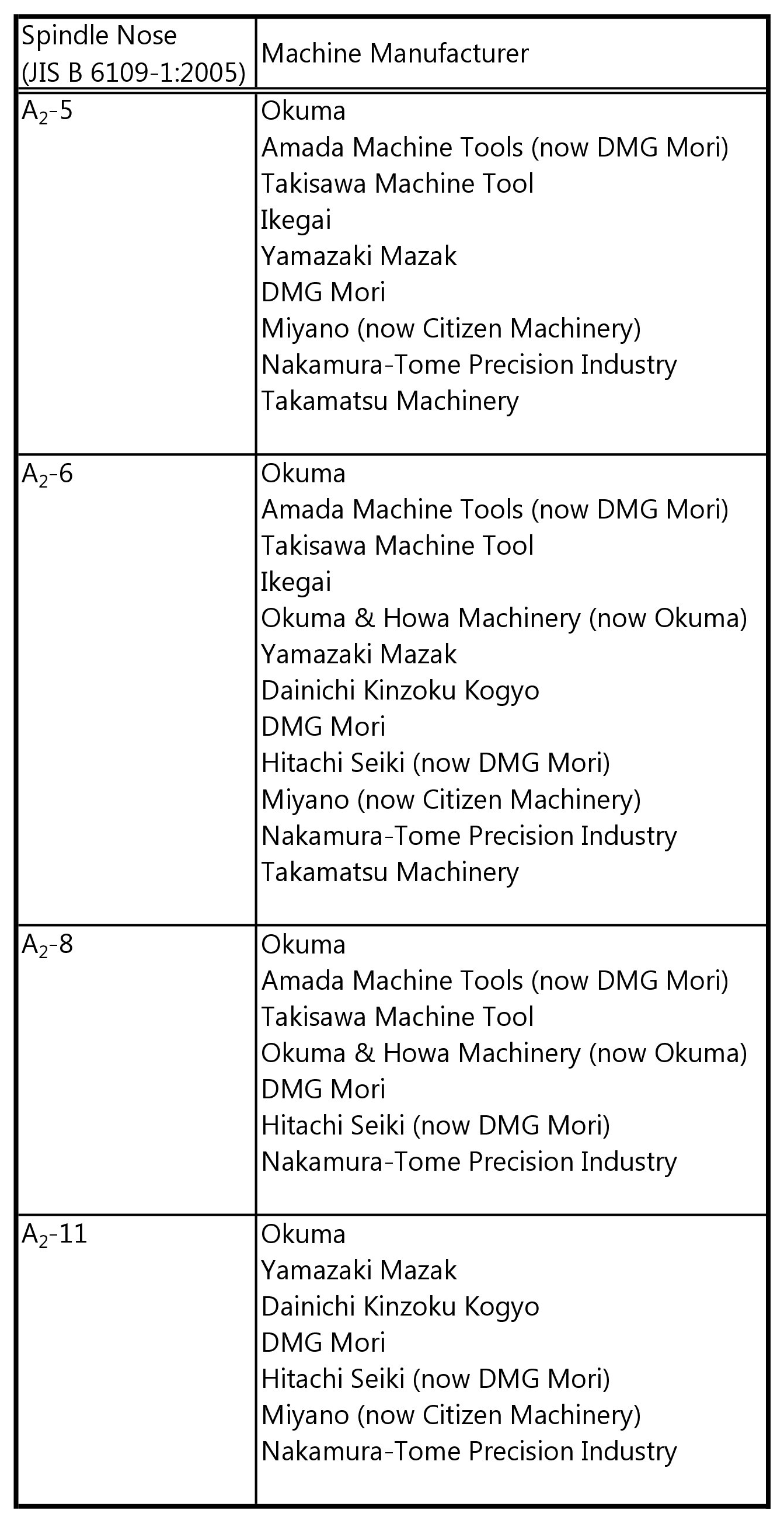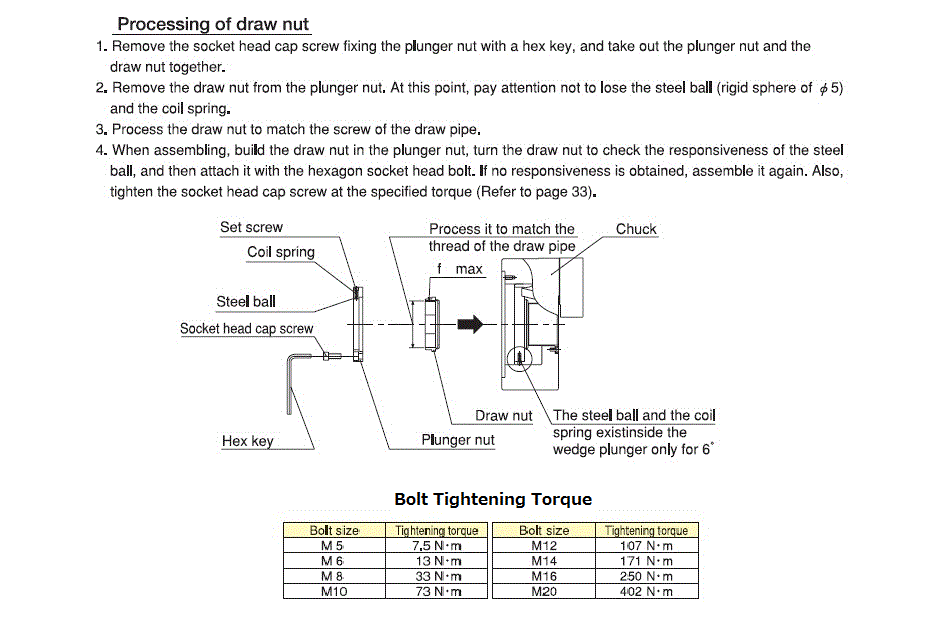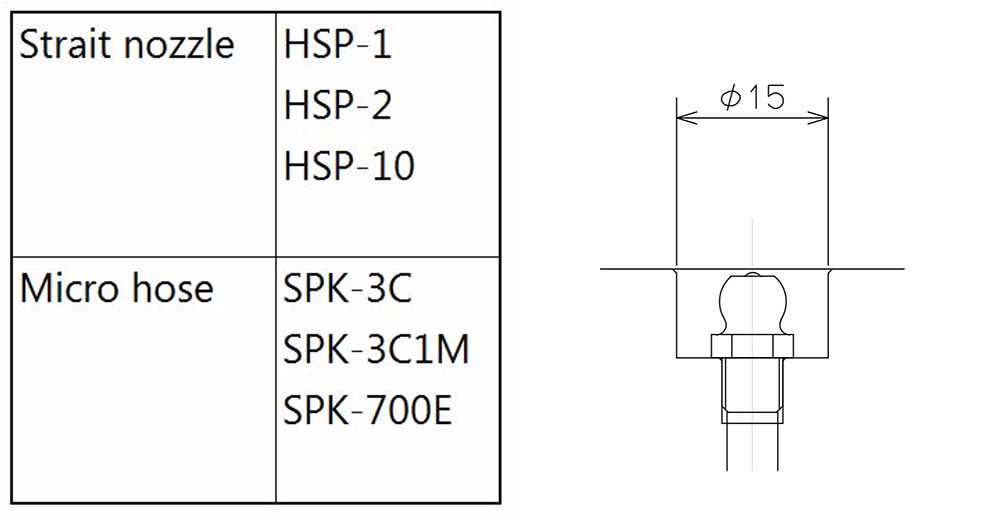Support Center
What are the components of the power chucks.
Please refer to here
B-200 series(PDF) N series(PDF)Which machine manufacture’s turning centre will Kitagawa standard taper (0 taper) back plate fit to?
Kitagawa standard taper (0 taper) backplates can fit to the lathes of manufacturers in the table below.
If you need back plates for machine manufacturers not on the table, please contact your local dealer.

I'd like to change the draw nut. Are there instructions?
Please refer to the instruction manual. The following is an excerpt from the instruction manual.

Is there a material that shows the type and shape of the grease nipple?
Please refer to the grease nipple page of the chuck catalogue. If you are looking for a nozzle for a grease gun, please refer to the answer to the next question.
I want to put grease in the chuck, which grease gun should I use?
The grease nipple of the BR chuck conforms to JIS B 1575: 2000 type 1 (parallel screw vertical type), and the counterbore diameter is φ15, so purchase a grease gun nozzle compatible with it.
The following table is compatible with Grease Gun nozzles of Yamada Corporation. Please see Yamada Corporation's website for details.
https://www.yamadacorp.co.jp/global/products/grease-gun/

I would like to install a jig on the power chuck surface. Please tell me the area of the power chuck surface where I can additionally machine.
Please refer to the attachment for the area where additional machining on B200 series, B series and N series is possible.
B-200 series B series N seriesWhen a thin workpiece is machined, the workpiece becomes deformed. How can I stop this from happening?
In order to reduce the deformation of the workpiece, it is necessary to first lower the gripping force of the chuck to the appropriate value.
↓
In order to lower the gripping force of the chuck, it is necessary to lower the thrust of the rotating hydraulic cylinder.
↓
Reducing the thrust of the cylinder may be dangerous. It may cause the work piece to fall out during rotation.
Force calculations for the thrust of the cylinder and the gripping force of the chuck should be mathematically calculated, not judged by eye or guessed.
Cylinder thrust calculation
Cylinder thrust = * Maximum piston thrust x {(working pressure - 0.25 MPa) / (*Maximum pressure - 0.25 MPa)}}.
Please extract the values for the cylinder model you are using from the cylinders catalogue.
Note: 0.25 is based on mechanical loss
Chuck gripping force calculation
Gripping force of chuck = * Maximum stationary gripping force × (cylinder thrust / *maximum allowable input)
Please extract the values for the chuck model you are using from the chucks catalogue.
Please make a chuck gripping force management table in order to avoid the workpiece falling out during rotation.
Note: Gripping force also varies depending on the conditions such as the jaw shape and rotation speed.I would like to know a good way to manage the gripping force of the chuck.
KITAGAWA recommends managing the actual gripping force using a static gripping force meter (JFT-S100A).
Even for chucks of the same specifications, the gripping force varies widely depending on various factors such as the greasing condition, the jaw shape, and the viscosity of hydraulic oil. Managing the gripping force is important because an unexpected drop in the gripping force causes the danger such as work scattering.
How can I select a rotating hydraulic cylinder?
KITAGAWA recommends a conforming cylinder for each chuck. Please check it in the catalogue.
How should I calculate the hydraulic pressure of the rotating hydraulic cylinder when replacing the power chuck?
Since the gradient of "hydraulic pressure-gripping force" varies depending on the chuck type, calculate the draw bar pull force (i.e. cylinder thrust) so that the gripping force is the same as the gripping force of the chuck before replacement by referring to the instruction manual. For your reference, the hydraulic pressure setting method for replacing BB200 with BR is attached.
Oil is leaking out of the rotary hydraulic cylinder. Is it possible to repair it by myself?
Because special test equipment is required for repair completion inspection, rotary hydraulic cylinder repair is done at dedicated factories only. Please contact your nearest dealer.
We also sell seal kits for cylinders according to customers’ requests. However, please understand that it will not be subject to our warranty if a customer replaces seals by himself. Please check the cylinder type and manufacturing number and contact your nearest dealer.
The rotary hydraulic cylinder is the most important device of the workholding system. Mistakes in reassembly may result in the workpiece scattering out during rotation, therefore, a fully trained and qualified engineer who has sufficient mechanical knowledge and understands the above content should repair.
I am using KITAGAWA CHUCK GREASE PRO. Please tell me the most suitable storage method.
Please store KITAGAWA CHUCK GREASE PRO as follows.
·Please store unopened grease in a cool and dark place.
·When storing half-used grease, keep the grease surface flat and completely cover and seal and store it in a cool and dark place.
·The shelf life of grease will be approximately three years after manufacturing if it is stored correctly.
However, grease will deteriorate even during storage and lose its lubricating function, so please use it as early as possible.
Degraded grease becomes darker colour and develops waste acid smell and a large amount of oil on the surface compared to new one. Please take this as sign.
Is there the Safety Data Sheet of KITAGAWA CHUCK GREASE PRO available?
Please download here below.
Safety Data Sheet in English (PDF)
Is there a "recommended air circuit diagram" for the KPC chuck?
There is a reference configuration diagram of the air circuit. Please refer to here.